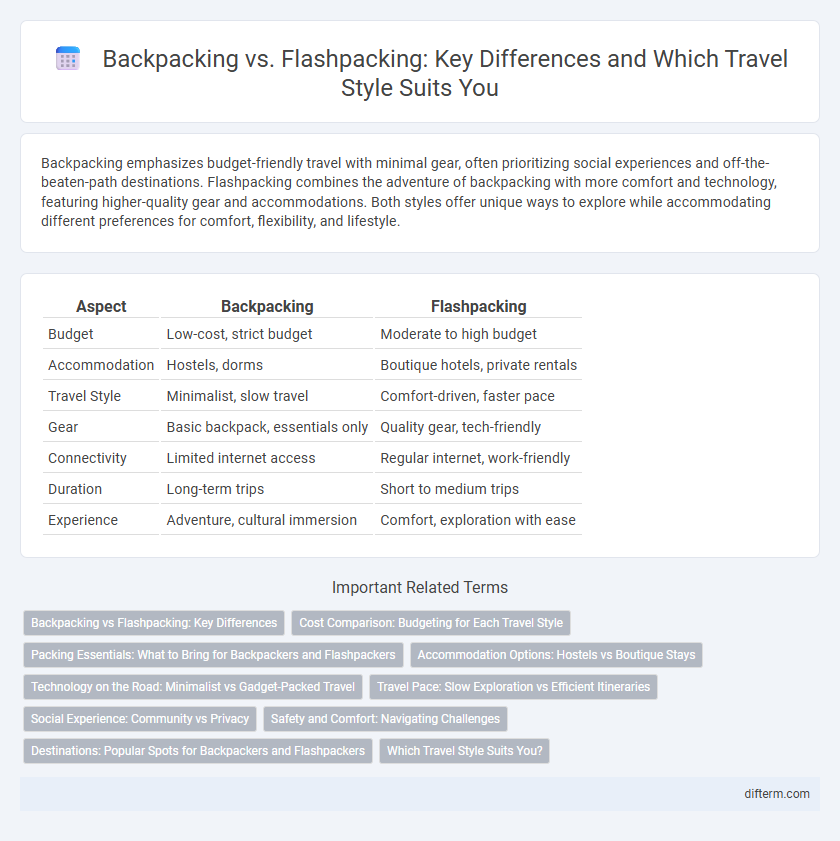Backpacking emphasizes budget-friendly travel with minimal gear, often prioritizing social experiences and off-the-beaten-path destinations. Flashpacking combines the adventure of backpacking with more comfort and technology, featuring higher-quality gear and accommodations. Both styles offer unique ways to explore while accommodating different preferences for comfort, flexibility, and lifestyle.
Table of Comparison
| Aspect | Backpacking | Flashpacking |
|---|---|---|
| Budget | Low-cost, strict budget | Moderate to high budget |
| Accommodation | Hostels, dorms | Boutique hotels, private rentals |
| Travel Style | Minimalist, slow travel | Comfort-driven, faster pace |
| Gear | Basic backpack, essentials only | Quality gear, tech-friendly |
| Connectivity | Limited internet access | Regular internet, work-friendly |
| Duration | Long-term trips | Short to medium trips |
| Experience | Adventure, cultural immersion | Comfort, exploration with ease |
Backpacking vs Flashpacking: Key Differences
Backpacking involves budget travel with minimal gear, emphasizing backpackers' flexibility and immersive local experiences, while flashpacking upgrades this with higher spending on comforts like quality accommodations and technology. Flashpackers prioritize connectivity and convenience, often carrying gadgets and choosing safer or more comfortable travel options compared to traditional backpackers. These distinctions highlight how backpacking focuses on simplicity and adventure, whereas flashpacking merges affordability with added luxury and modern amenities.
Cost Comparison: Budgeting for Each Travel Style
Backpacking typically involves minimal expenses, with an average daily budget ranging from $20 to $50, focusing on hostels, street food, and public transportation to maximize cost-efficiency. Flashpacking, on the other hand, combines budget travel with comfort, often allocating $50 to $150 daily for boutique accommodations, reliable internet access, and occasional splurges on experiences. Understanding these cost differences helps travelers allocate funds effectively, balancing affordability with desired comfort levels.
Packing Essentials: What to Bring for Backpackers and Flashpackers
Backpackers prioritize lightweight and multipurpose gear such as compact sleeping bags, durable backpacks, and reusable water bottles to maximize mobility and minimize load. Flashpackers tend to pack more advanced electronics, portable chargers, and versatile clothing for urban and remote environments, balancing comfort with functionality. Essential items for both include travel documents, first aid kits, and adaptable footwear suitable for diverse terrains.
Accommodation Options: Hostels vs Boutique Stays
Hostels offer budget-friendly accommodation with shared dormitories, fostering social interaction and a communal atmosphere ideal for backpackers seeking affordability and cultural exchange. Boutique stays provide a more personalized and upscale experience, featuring private rooms, unique decor, and enhanced amenities that appeal to flashpackers valuing comfort and individuality. Choosing between hostels and boutique stays depends on travelers' priorities for cost, privacy, and authentic local experiences.
Technology on the Road: Minimalist vs Gadget-Packed Travel
Backpacking emphasizes minimalistic technology, favoring essential gadgets like smartphones, portable chargers, and lightweight cameras to maintain mobility and reduce weight. Flashpacking incorporates advanced tech such as laptops, drones, high-end cameras, and multiple smart devices to enhance comfort, productivity, and multimedia capabilities while traveling. Both styles utilize technology tailored to their travel ethos, balancing convenience and functionality on the road.
Travel Pace: Slow Exploration vs Efficient Itineraries
Backpacking embraces a slow exploration pace, allowing travelers to immerse deeply in local cultures and discover hidden gems at their own rhythm. Flashpacking favors efficient itineraries, balancing adventure with comfort while covering more destinations within limited timeframes. This contrast in travel pace shapes the overall experience, catering to either immersive journeys or dynamic, time-sensitive adventures.
Social Experience: Community vs Privacy
Backpacking offers a rich social experience through communal hostels, group tours, and shared accommodations, fostering connections with diverse travelers and local cultures. Flashpacking tends to provide more privacy with private rooms and personalized experiences, appealing to those who prefer solitude or selective social interactions. The choice between backpacking and flashpacking significantly influences the balance between community engagement and personal space during travel.
Safety and Comfort: Navigating Challenges
Backpacking often involves budget accommodations and basic facilities, which can pose safety risks and reduce comfort due to limited resources and unpredictable environments. Flashpacking combines the spirit of backpacking with the advantage of modern technology and higher budgets, offering enhanced safety measures such as secure lodging and access to reliable transportation. The balance of comfort and security in flashpacking minimizes common travel challenges, making it an appealing choice for those prioritizing well-being during adventurous journeys.
Destinations: Popular Spots for Backpackers and Flashpackers
Backpackers often explore budget-friendly destinations like Southeast Asia's Thailand and Vietnam, known for vibrant street markets and cultural homestays. Flashpackers tend to gravitate toward more upscale locations such as Bali, Indonesia, and Lisbon, Portugal, where boutique hotels and curated experiences blend adventure with comfort. Both groups frequently intersect at iconic spots like Machu Picchu and the backpacker-friendly hostels of Barcelona, offering varied options tailored to their travel styles.
Which Travel Style Suits You?
Backpacking offers budget-friendly adventure, ideal for travelers seeking flexibility and cultural immersion through basic accommodations and local experiences. Flashpacking caters to those preferring comfort and connectivity, combining traditional backpacking with upscale gear, reliable Wi-Fi, and occasional luxury stays. Choosing between backpacking and flashpacking depends on your priorities for cost, convenience, and the type of travel experience you desire.
backpacking vs flashpacking Infographic

 difterm.com
difterm.com